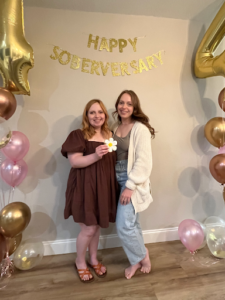National Recovery Month, also known simply as Recovery Month, is held each year throughout the month of September to celebrate the progress made by people in recovery. It also aims to educate others on the successful impacts of substance use treatment and mental health services. Recovery month helps to destigmatize addiction and reinforce the truth that people can, and do, recover.
Just a few years ago, this annual recognition meant little to me. I was a naive, recent college graduate who did not personally know (or, more likely, didn’t know that I knew) anyone facing addiction or in recovery. However, in March of 2020, something life changing occurred that shifted my view of recovery and addiction forever — my twin sister, Katie, became sober.

What you should know about my sister and me is that we are close. You know the old cliches about twins being inseparable? We’re like that, but even closer. We talk every day; we erupt into what we like to call ‘sissy giggles’ every time we are together; and we understand each other intuitively like no one else can. So, let me tell you, her recovery was difficult – of course for her, but also for me.
I never realized how many steps there are to recovery. First there’s detox, then in-patient rehabilitation, then hybrid rehabilitation, then outpatient rehabilitation, then sober living, and so on until the person feels they can successfully continue recovery independently. And these steps aren’t always linear. Luckily, for Katie, they were, and she did not relapse at any point in her journey. Yet for many other people, the road is less straightforward and can look something more like: detox, inpatient, relapse, detox, inpatient, outpatient, relapse, detox, inpatient, etc… This is why AA (alcoholics anonymous) never labels someone as “recovered.” Rather, people who are facing addiction often use the word “recovering” for the rest of their lives.
For Katie, detox was the hardest part of the journey. Although she decided to enter into detox out of her own volition, it was still hard for her to walk into the facility. Walking inside meant cutting off all contact with the outside world for 10-14 days and giving up alcohol forever. No champagne toast at my upcoming wedding; no beer at a baseball game; no wine in Napa.
I never realized how many social events and celebrations were tied to alcohol until I started to mourn these experiences for my sister. And wow, not being able to talk to her during the hardest couple of weeks of her life… Well, it was awful. I’ve always been protective of my sister, and not being able to make sure she was okay made me feel helpless, guilty, and some days, a little panicked. I mean, I knew she was okay, but I wanted to be there to go through the process alongside her, and I couldn’t.
At one point during detox, an exception was made, and Katie was able to give me a brief 5-minute call. As I had hoped, she was doing fine, but she sounded tired, defeated, and just generally down. She is one of those people who is always so full of life, bubbliness, and positivity, that hearing her like this broke me. All I could do in that moment was listen, sympathize, and remind myself that the hardship she was experiencing was necessary for her long-term health and safety.
We had many more of these short, monitored conversations over the next several months. Katie had no access to her cell phone until she was in sober living, so from March until May, our only communication came in the form of one or two 10-minute phone calls each week. My life started to revolve around these calls. When would my phone ring? What should I say? Should I tell her about my day? Or just ask how she is doing? Am I saying the right things? What happens if I say the wrong thing? Being so intrinsically connected to her for all of my 25 years — then suddenly being severely cut off from her — was one of the hardest things I’ve experienced.
In the grand scheme of things, Katie was set up for success. She was a functioning alcoholic: she binge-drank most nights but she didn’t touch alcohol until 7pm and was sober at work, at family events, etc. Her journey to recovery was much easier than most people’s, but it was hard nonetheless.
And that I expected. I knew that recovery was going to be hard for my sister, but I never quite grasped the toll it took on the families of those who are in recovery. I certainly wasn’t the only person in my family to be impacted. Our parents were heartbroken and often felt guilty. Had they done something to cause this? Was dropping her off at this facility the right thing to do? What would these two months in rehab mean for my sister’s career, friendships, and independence?
But the truth is, addiction is a disease, as much as diabetes or asthma. In fact, the Brain Disease Model of Addiction, or BDMA, recognizes that there are a combination of neurobiological, genetic, environmental, and social factors that lead to addiction. For the most part, becoming an addict is out of the addicted person’s control.
Many people might have a knee-jerk reaction to that statement – I know I did at first. Honestly, I thought it was irresponsible for Katie’s treatment program to endorse a view that diffused her responsibility in the matter. But I couldn’t have been more wrong.
Evidence-based treatments are just that — research-, data- and evidence-based. And once Katie understood her alcoholism was predisposed, it empowered her toward recovery. She no longer thought she could escape it. She no longer thought that maybe one day she could drink “normally.” She was able to recognize and fully accept her condition and start her walk down the path of recovery.
The other benefit of the Brain Disease Model of Addiction is that it empowers people who are facing addiction to seek out medical and non-medical treatments, just as one might for anxiety or depression. Seeing a therapist and attending AA meetings is highly recommended — just like seeing a therapist is for other mental health conditions — but there is also a chemical component to addiction, similar to the way that low serotonin levels are associated with depression and anxiety. As such, BDMA encourages people with addiction to seek out a combination of medical, social, and environmental treatments. And as we know with other mental health diagnoses, having a combination of treatments is often more effective than just having one.

I am so proud to share Katie’s story this National Recovery Month. Her recovery has defined her in the best ways possible. Although addiction is usually shrouded with stigma, Katie’s doesn’t feel like something to be embarrassed of or ashamed about. It’s something to be celebrated! In fact, for the past three years, I’ve hosted her annual soberversary party!
Katie’s recovery turned her back into the ray of sunshine I grew up with. It made her realize the impact of her actions on other people, and it made her the happiest, healthiest version of herself. It is, without a doubt, the thing I am most proud of her for. It wasn’t easy for her to get this far and the journey will continue to be hard. But I will always be in her corner, advocating for her, supporting her, and celebrating each milestone along the way.
Kaela Sosa is co-founder and Manager, Curriculum and Programming at The Diversity Movement. Her expertise includes psychology, gender identity and sexual orientation and racial identities. Kaela has written and spoken about a range of topics: active allyship, the inclusive talent lifecycle, disability etiquette, LGBTQ+ inclusion and inclusive language. At The Diversity Movement, she leads the development and execution of learning programs, including digital learning, online courses, certificate programs and certification opportunities. Connect with or follow Kaela on Linkedin to learn more.




